15 Korean Lobster Recipes to Try Now
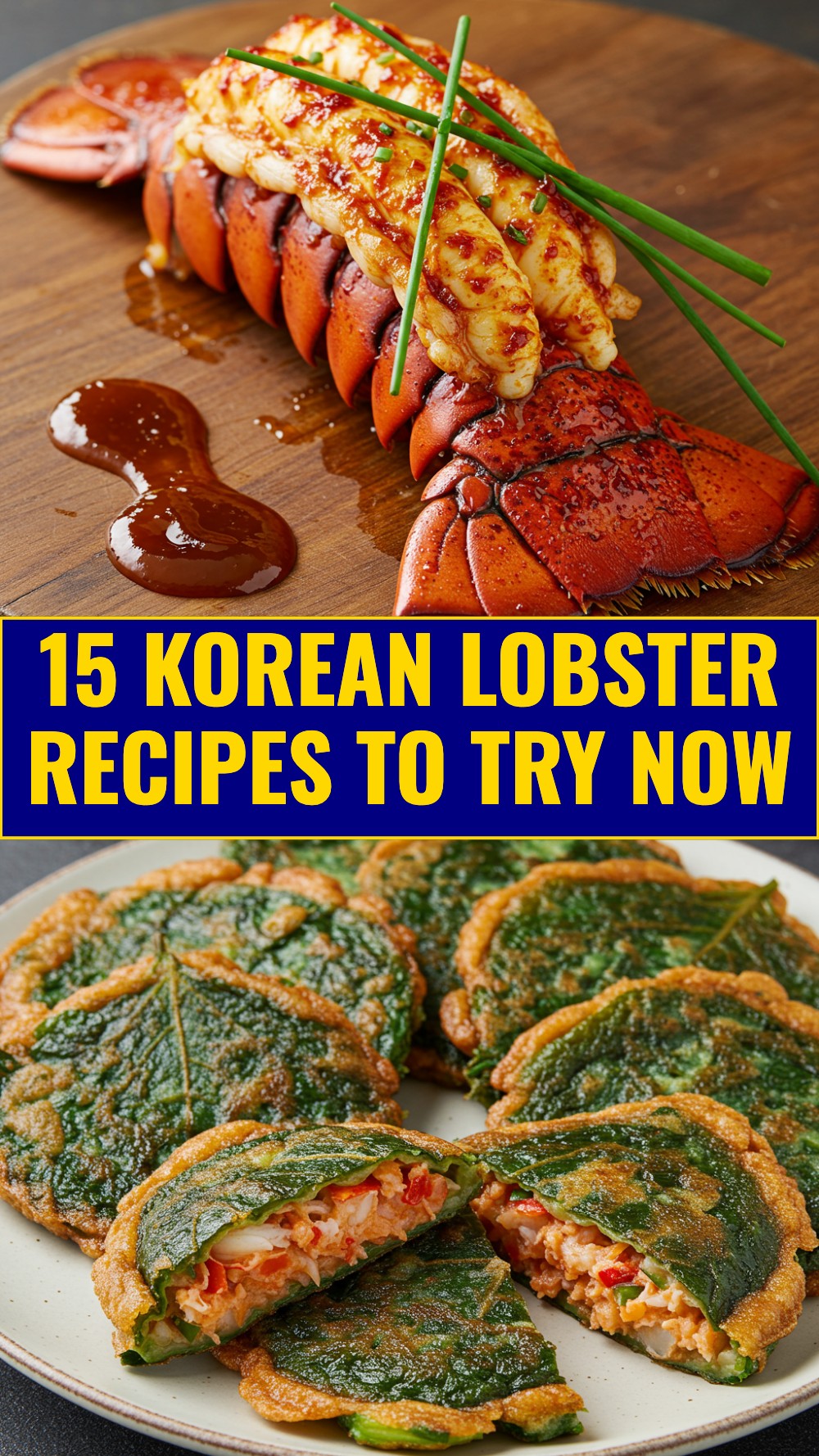
Ready to take your lobster game to the next level? Forget everything you thought you knew and get ready to explore the bold, vibrant, and utterly delicious world of Korean lobster recipes. From spicy and savory to cheesy and decadent, these 15 recipes will transform the way you see lobster and have you cooking like a pro in your own kitchen.
“Korean cuisine is all about the balance of ‘jang’ (fermented sauces), ‘maeun’ (spiciness), and ‘dan’ (sweetness). Applying these principles to a delicate ingredient like lobster creates an explosion of flavor that is both exciting and harmonious.” – Chef Hooni Kim, author of “My Korea”
Korean Lobster Styles at a Glance
| Style | Key Flavors | Best For | Difficulty |
|---|---|---|---|
| Gochujang Butter | Spicy, Savory, Buttery | Those who love a kick of heat. | Easy |
| Cheese Lobster | Cheesy, Creamy, Rich | An indulgent, crowd-pleasing feast. | Medium |
| Soy-Garlic (Ganjang) | Salty, Sweet, Garlicky | A classic, savory flavor profile. | Easy |
| Doenjang Glaze | Umami, Earthy, Salty | Adventurous eaters seeking deep flavor. | Medium |
| Korean BBQ Style | Smoky, Sweet, Savory | Fans of classic Korean BBQ flavors. | Easy |
Your Ultimate Guide to Korean-Style Lobster
Korean cooking is a masterclass in flavor dynamics. It’s about creating layers of taste that dance on your palate—spicy, sweet, savory, and tangy all at once. When you apply this philosophy to the sweet, succulent meat of lobster, something truly magical happens.
You don’t need to be a master chef or have a professional kitchen to tackle these recipes. We’ll guide you through every step, from preparing the lobster to mastering the signature Korean sauces that make these dishes so special. Whether you’re using a grill, an oven, or your stovetop, get ready to create some of the most exciting lobster dishes you’ve ever tasted.
1. Gochujang Butter Roasted Lobster Tails
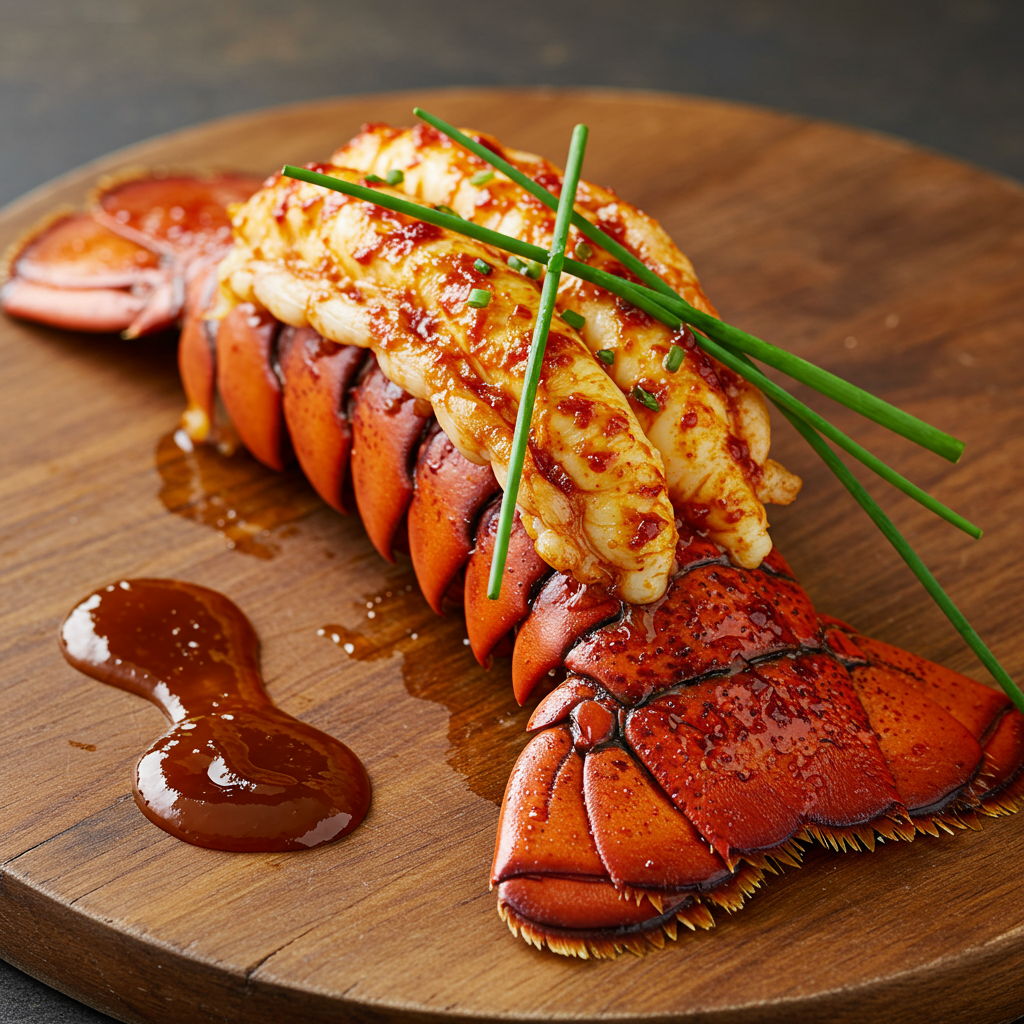
This is the perfect entry point into Korean lobster. The spicy, savory funk of gochujang (Korean chili paste) mixed with rich butter creates a sauce that’s simply addictive. It’s bold, it’s easy, and it’s unbelievably good.
Ingredients:
- 4 lobster tails (6-8 oz each)
- 1/2 cup unsalted butter, melted
- 3 tablespoons gochujang
- 2 tablespoons honey or maple syrup
- 3 cloves garlic, minced
- 1 tablespoon soy sauce
- 1 tablespoon rice vinegar
- Chopped chives or green onions for garnish
Instructions:
- Prep the Lobster: Preheat your oven to 400°F (200°C). Use kitchen shears to cut down the top center of the lobster shells. Gently pry the shell open and lift the meat, placing it on top of the shell (butterflied).
- Make the Gochujang Butter: In a bowl, whisk together the melted butter, gochujang, honey, minced garlic, soy sauce, and rice vinegar until it’s a smooth, vibrant red sauce.
- Sauce the Lobster: Place the prepared lobster tails on a baking sheet. Brush a generous layer of the gochujang butter all over the exposed lobster meat. Reserve some sauce for later.
- Roast to Perfection: Roast in the preheated oven for 12-15 minutes. The lobster meat should be opaque and the sauce should be bubbly and slightly caramelized.
- Final Touch: In the last 2 minutes of cooking, brush the lobster with the remaining gochujang butter.
- Garnish and Serve: Remove from the oven, garnish with fresh chives, and serve immediately.
Pro-Tip: Every brand of gochujang has a different level of spiciness and sweetness. Taste your sauce before brushing it on the lobster and adjust the honey or gochujang to your liking.
2. Korean Cheesy Lobster (Cheese Lobster Gui)
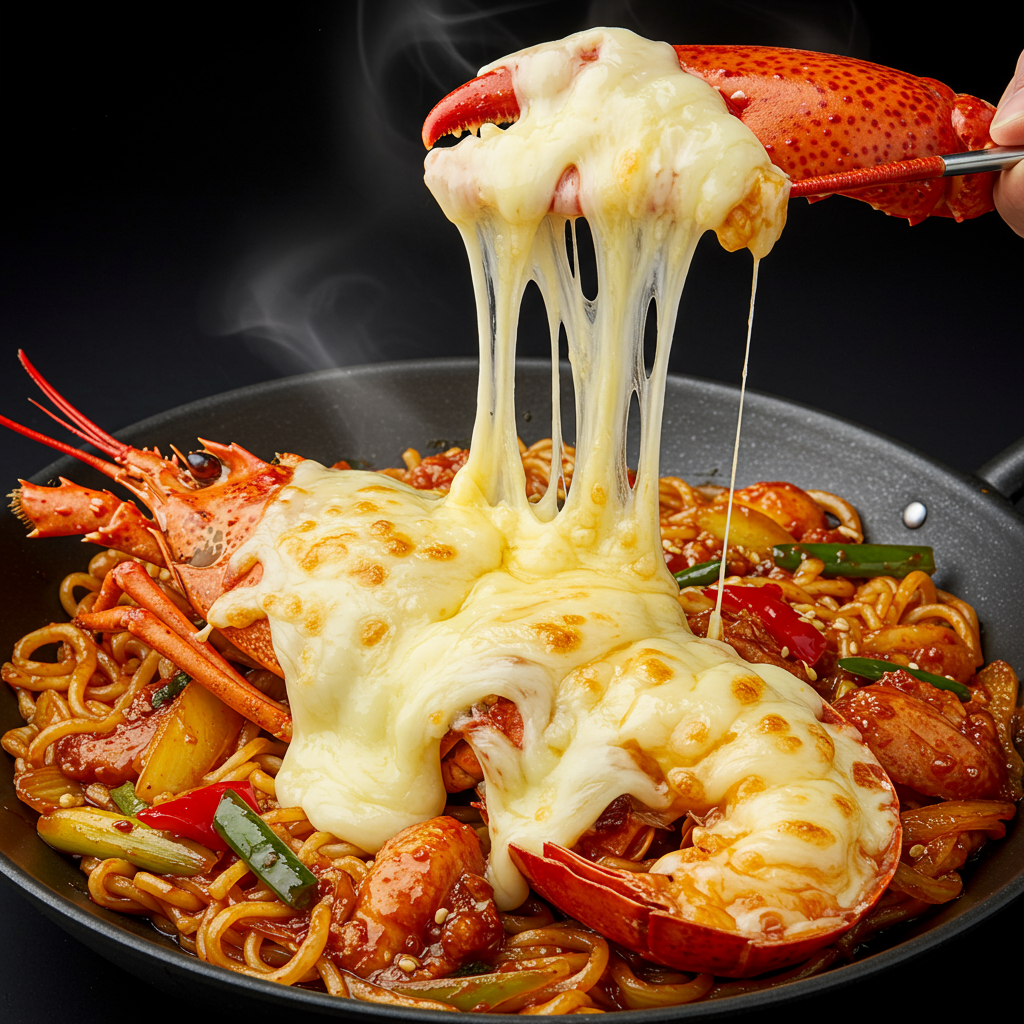
This is pure indulgence. A popular dish in Korean seafood restaurants, this recipe tops lobster with a blanket of melted mozzarella cheese. The combination of sweet lobster and savory, stretchy cheese is a match made in heaven.
Ingredients:
- 2 whole lobsters (about 1.5 lbs each), split in half lengthwise
- 1 cup shredded low-moisture mozzarella cheese
- 1/2 cup mayonnaise
- 2 tablespoons chopped onion
- 2 tablespoons chopped bell pepper (any color)
- 1 tablespoon sugar
- Salt and black pepper
- Chopped parsley for garnish
Instructions:
- Prep the Lobster: Preheat your oven’s broiler on high. Place the lobster halves, meat-side up, on a baking sheet lined with foil. Lightly season the meat with salt and pepper.
- Mix the Topping: In a bowl, combine the shredded mozzarella, mayonnaise, chopped onion, bell pepper, and sugar. Mix well until everything is incorporated.
- Top the Lobster: Spread the cheese mixture evenly over the lobster meat on all four halves.
- Broil Until Bubbly: Place the baking sheet under the broiler, about 6 inches from the heat source. Broil for 5-8 minutes, or until the cheese is melted, bubbly, and starting to get golden brown spots. Keep a very close eye on it to prevent burning!
- Garnish and Serve: Carefully remove from the oven. Let it cool for a minute before garnishing with chopped parsley. Serve hot.
Pro-Tip: For extra flavor, mix a tablespoon of corn into the cheese and mayonnaise mixture. The sweetness of the corn is a classic addition to this dish.
3. Soy-Garlic Glazed Lobster Skewers
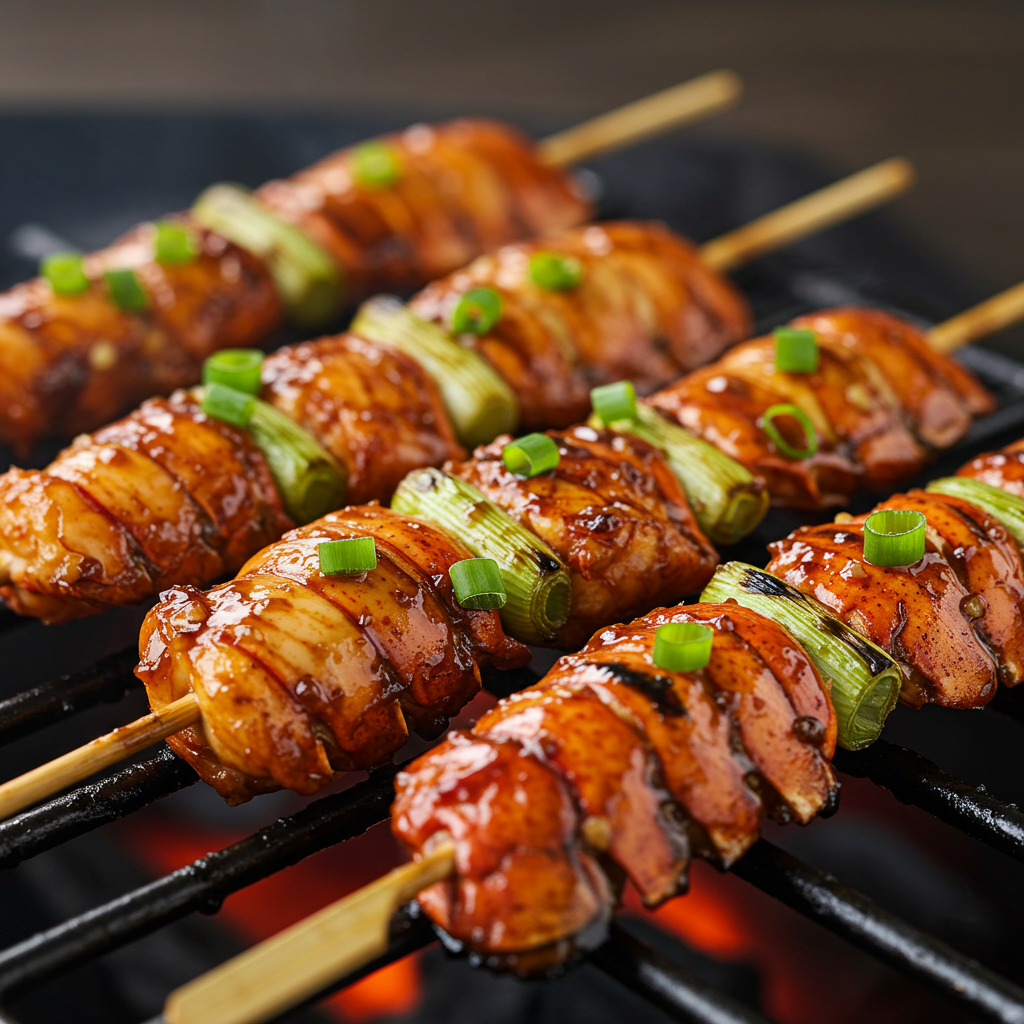
This recipe takes the classic sweet and savory flavors of a soy-garlic marinade and applies them to easy-to-eat lobster skewers. Perfect for grilling, these are a guaranteed hit at any cookout.
Ingredients:
- Meat from 4 large lobster tails, cut into 1.5-inch chunks
- For the Marinade:
- 1/2 cup soy sauce
- 1/4 cup water
- 3 tablespoons brown sugar or honey
- 4 cloves garlic, minced
- 1 tablespoon sesame oil
- 1 tablespoon mirin (sweet rice seasoning)
- 1 teaspoon grated fresh ginger
- 1 green onion, thinly sliced
- Wooden or metal skewers
Instructions:
- Make the Marinade: In a bowl, whisk together all the marinade ingredients: soy sauce, water, brown sugar, garlic, sesame oil, mirin, ginger, and green onion.
- Marinate the Lobster: Add the lobster chunks to the marinade and toss gently to coat. Let it marinate for at least 20 minutes, but no more than an hour (the acid can start to cook the lobster).
- Skewer the Lobster: Soak wooden skewers in water for 30 minutes to prevent burning. Thread the marinated lobster chunks onto the skewers.
- Grill or Pan-Sear: Preheat your grill or a large skillet to medium-high heat. Cook the skewers for 2-3 minutes per side, until the lobster is opaque and has nice char marks. Baste with any leftover marinade while cooking.
- Serve: Serve the skewers hot, garnished with extra sliced green onion or toasted sesame seeds.
Pro-Tip: You can add vegetables like bell peppers, zucchini, or onions to the skewers for a more complete and colorful meal.
4. Doenjang Brown Butter Lobster

Doenjang, a fermented soybean paste, is one of the pillars of Korean cooking. It’s earthy, salty, and packed with umami. Combining it with nutty brown butter creates a sophisticated and deeply flavorful sauce for lobster.
Ingredients:
- 4 lobster tails, butterflied
- 1/2 cup unsalted butter
- 2 tablespoons doenjang
- 2 cloves garlic, minced
- 1 tablespoon honey
- 1 tablespoon lemon juice
- Toasted walnuts or pecans, chopped, for garnish
Instructions:
- Make the Brown Butter: In a light-colored skillet, melt the butter over medium heat. Continue to cook, swirling the pan occasionally, until the butter foams, then subsides, and brown specks appear at the bottom. It will smell nutty and delicious. Be careful not to burn it.
- Create the Sauce: Once the butter is browned, remove it from the heat immediately. Whisk in the doenjang, minced garlic, honey, and lemon juice until smooth.
- Cook the Lobster: Preheat your grill or a skillet to medium-high. Place the butterflied lobster tails meat-side down and cook for 3-4 minutes.
- Flip and Sauce: Flip the lobster tails over so they are shell-side down. Spoon the doenjang brown butter sauce generously over the meat.
- Finish Cooking: Cook for another 4-5 minutes, until the lobster meat is firm and opaque.
- Garnish and Serve: Remove from the heat, garnish with chopped toasted nuts, and serve immediately.
Pro-Tip: Browning butter takes patience. Keep the heat on medium and don’t walk away from the pan. The transition from browned to burned is very quick!
5. Korean BBQ Lobster Tails
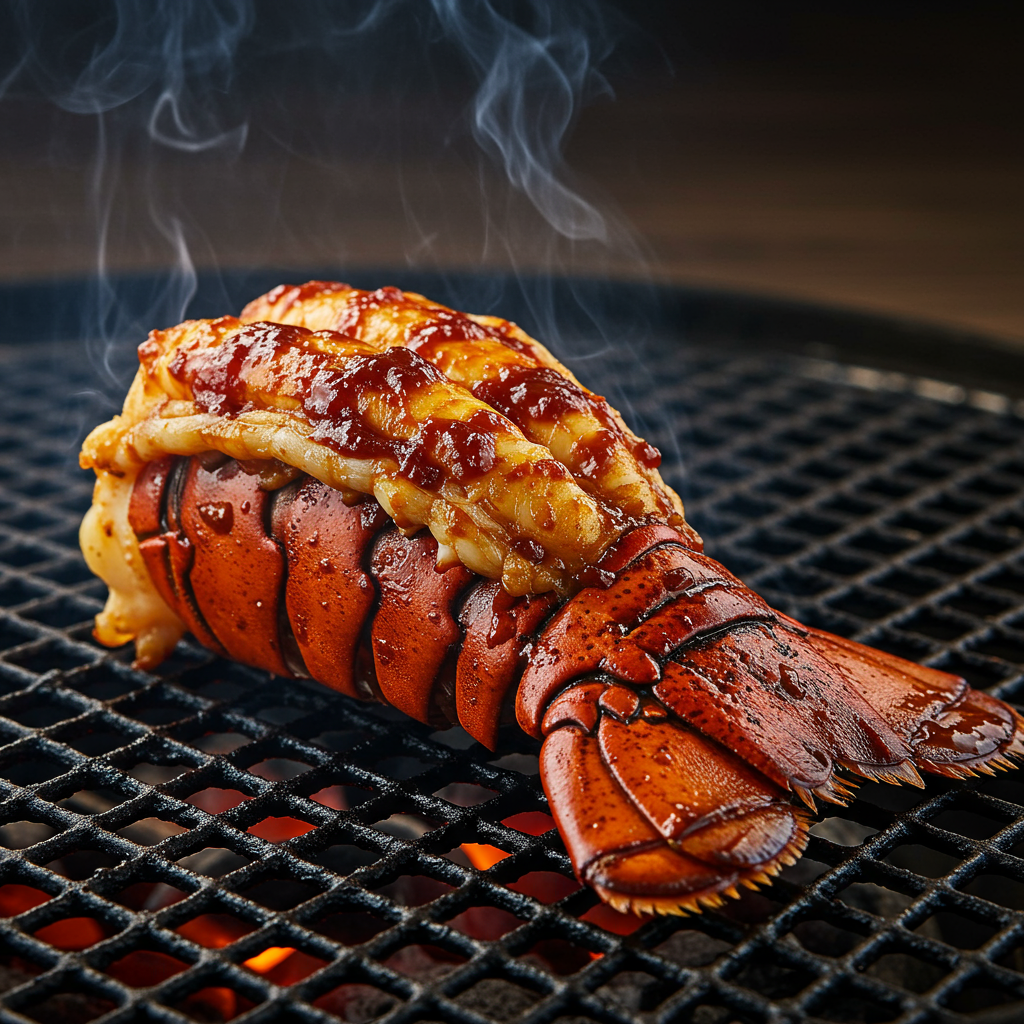
All the smoky, sweet, and savory flavors of your favorite Korean BBQ, but with lobster! This marinade is quick to make and gives the lobster an incredible flavor that’s perfect for grilling.
Ingredients:
- 4 lobster tails, butterflied
- For the Marinade:
- 1/4 cup soy sauce
- 2 tablespoons gochujang
- 2 tablespoons brown sugar
- 1 tablespoon sesame oil
- 2 cloves garlic, minced
- 1 tablespoon rice vinegar
- 1 pear, grated (Bosc or Asian pear works best)
Instructions:
- Make the K-BBQ Marinade: In a bowl, combine all the marinade ingredients. The grated pear is a traditional Korean technique that acts as a natural sweetener and tenderizer.
- Marinate: Brush the marinade all over the lobster meat. Let it sit for about 15-20 minutes.
- Grill: Preheat your grill to medium-high. Place the lobster tails shell-side down. Grill for 8-10 minutes, basting with more marinade every few minutes, until the lobster is cooked through and the glaze is caramelized.
- Serve: Serve hot, garnished with sesame seeds. This is fantastic with a side of kimchi and steamed rice.
Pro-Tip: For the best flavor, cook this over a charcoal grill to get that authentic smoky taste.
6. Lobster Japchae (Glass Noodle Stir-fry)
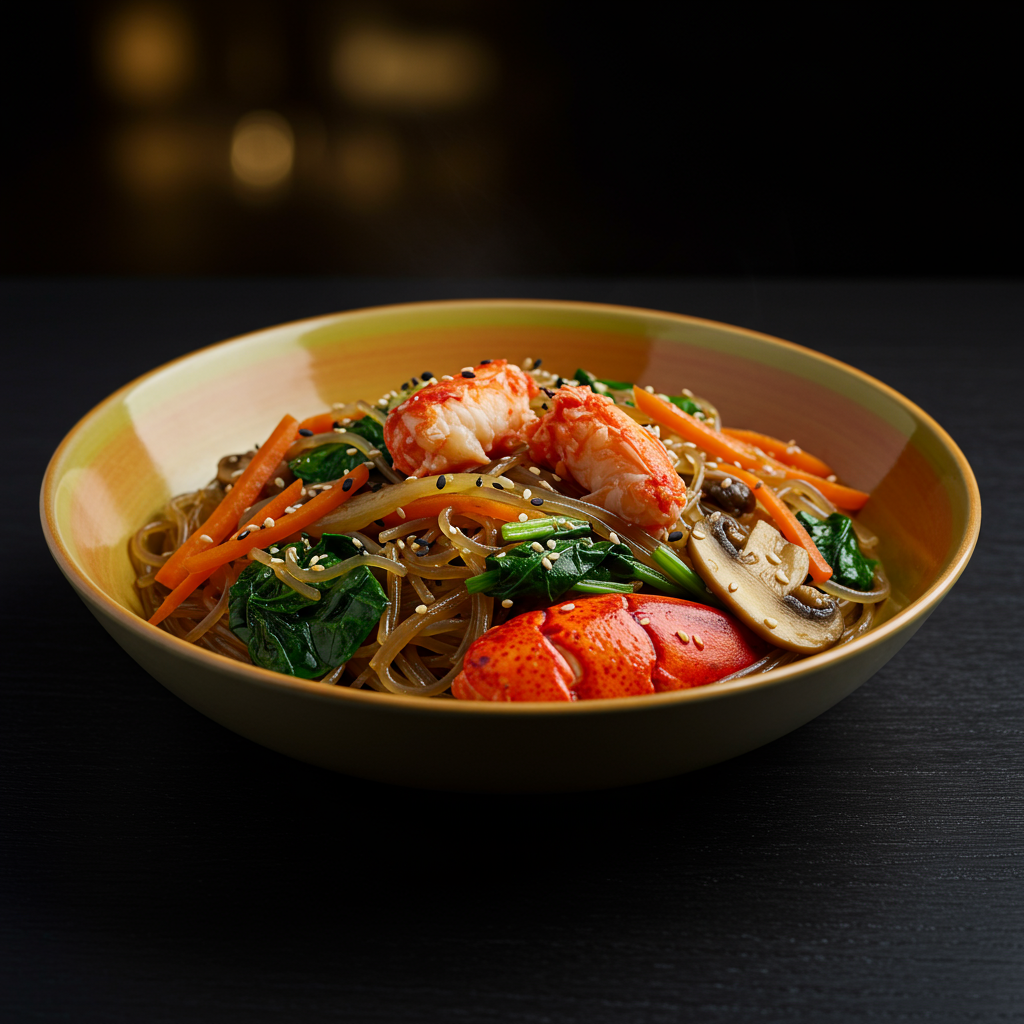
Japchae is a beloved Korean noodle dish. While typically made with beef, substituting stir-fried lobster chunks makes it a luxurious and celebratory meal.
Ingredients:
- 8 oz Korean sweet potato starch noodles (dangmyeon)
- Meat from 2-3 lobster tails, cut into bite-sized pieces
- 1 carrot, julienned
- 1/2 onion, thinly sliced
- 4 oz spinach, blanched and squeezed dry
- 5-6 shiitake mushrooms, sliced
- For the Sauce:
- 1/4 cup soy sauce
- 2 tablespoons sesame oil
- 2 tablespoons sugar or honey
- 2 cloves garlic, minced
- Salt and pepper
Instructions:
- Cook Noodles: Cook the sweet potato noodles according to package directions. Rinse under cold water, drain well, and cut a few times with scissors. Toss with 1 tablespoon of sesame oil to prevent sticking.
- Sauté Vegetables: In a large wok or skillet, stir-fry the carrot, onion, and mushrooms separately with a little oil until tender-crisp. Season each with a pinch of salt.
- Cook Lobster: In the same pan, add a bit more oil and stir-fry the lobster pieces for 2-3 minutes until just cooked through. Remove from the pan.
- Combine: Return the noodles to the pan. Add the cooked vegetables, spinach, and lobster.
- Sauce and Toss: Pour the sauce ingredients (soy sauce, sesame oil, sugar, garlic) over everything. Toss well over low heat for 1-2 minutes until everything is heated through and well-coated.
- Serve: Garnish with toasted sesame seeds and serve warm or at room temperature.
Pro-Tip: The key to great japchae is to cook the ingredients separately to maintain their individual flavors and textures before combining them at the end.
7. Spicy Korean Lobster Stew (Haemul Jjigae)
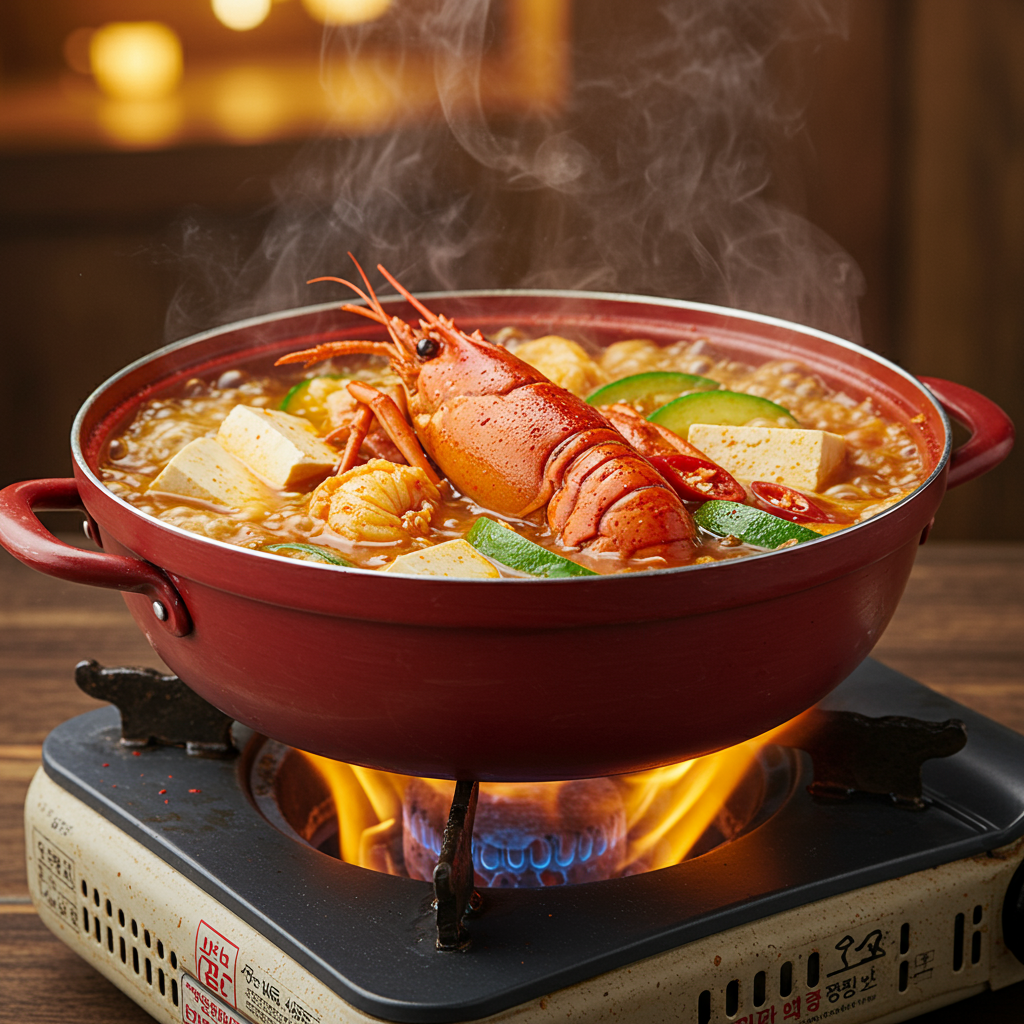
A hearty, spicy, and comforting stew perfect for a chilly day. This is a seafood-focused version of a classic Korean jjigae, with lobster as the star.
Ingredients:
- 1 whole lobster, cut into 2-inch pieces (shell on)
- 4 cups anchovy or vegetable broth
- 1/2 block of soft tofu, cubed
- 1/2 onion, sliced
- 1 zucchini, sliced into half-moons
- 2 green onions, chopped
- For the Seasoning Paste:
- 3 tablespoons gochugaru (Korean chili flakes)
- 2 tablespoons gochujang
- 1 tablespoon doenjang
- 2 cloves garlic, minced
- 1 teaspoon fish sauce
Instructions:
- Make the Paste: In a small bowl, mix all the seasoning paste ingredients together.
- Start the Stew: In a medium pot, bring the broth to a boil. Add the seasoning paste and stir until it dissolves.
- Add Ingredients: Add the onion, zucchini, and lobster pieces to the pot. Bring back to a boil, then reduce heat and simmer for 10-12 minutes, until the lobster is cooked.
- Finish with Tofu: Gently add the soft tofu and chopped green onions. Simmer for another 2-3 minutes.
- Serve: Serve bubbling hot in the pot with a side of steamed rice.
Pro-Tip: For a richer broth, you can make a quick stock by boiling the lobster shells (if you have extra) with some dried anchovies and kelp for 20 minutes before starting the stew.
8. Korean-Style Lobster Rolls
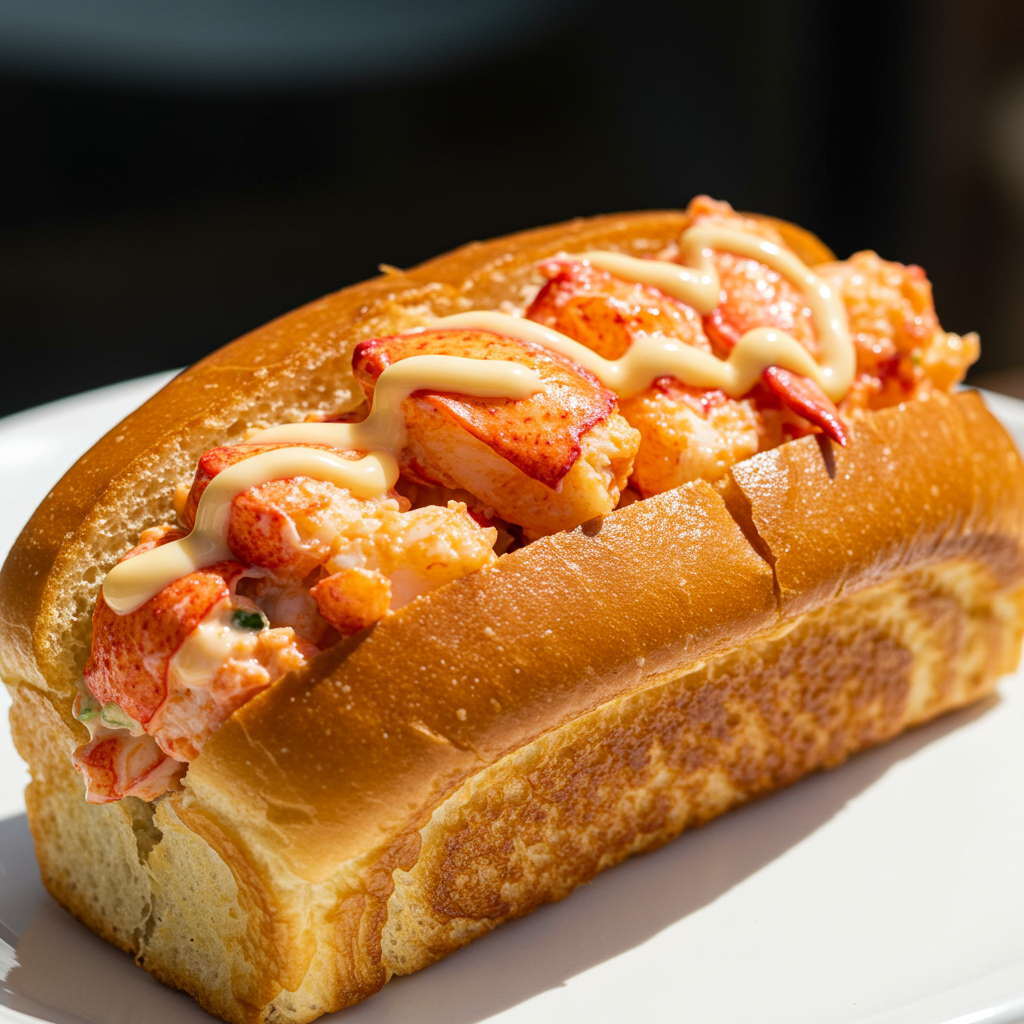
A fun Korean twist on the classic New England lobster roll. The lobster is dressed in a creamy, slightly spicy gochujang-based mayonnaise.
Ingredients:
- Meat from 2 cooked lobsters, chilled and chopped
- 1/2 cup mayonnaise (Kewpie mayo recommended)
- 1 tablespoon gochujang
- 1 teaspoon sesame oil
- 1 tablespoon chopped chives or green onions
- 1 celery stalk, finely chopped
- 4 split-top hot dog buns
- 2 tablespoons butter, melted
Instructions:
- Make the Dressing: In a bowl, whisk together the mayonnaise, gochujang, and sesame oil.
- Mix the Salad: Gently fold in the chilled lobster meat, chives, and celery. Season with a pinch of salt if needed.
- Toast the Buns: Brush the sides of the hot dog buns with melted butter. Toast in a skillet over medium heat until golden brown and crisp.
- Assemble: Fill the toasted buns generously with the Korean lobster salad.
- Serve: Serve immediately, perhaps with a side of shrimp crackers or pickled radish.
Pro-Tip: Chilling the cooked lobster meat before making the salad is crucial. It helps the meat stay firm and not get mushy when you mix it with the dressing.
9. Garlic Butter Kimchi Lobster
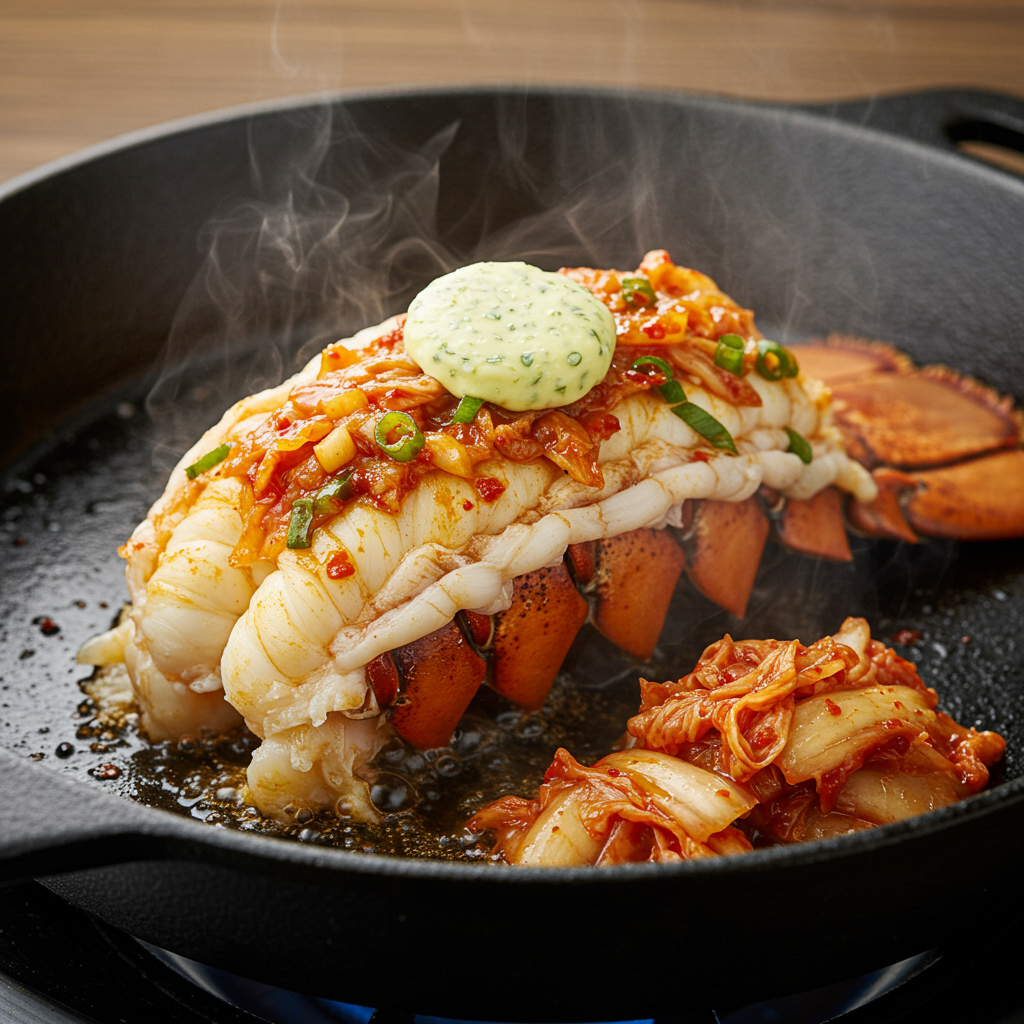
The tangy, spicy crunch of kimchi cuts through the richness of the garlic butter and lobster for a perfectly balanced and incredibly flavorful dish.
Ingredients:
- 4 lobster tails, butterflied
- 1/2 cup unsalted butter, melted
- 4 cloves garlic, minced
- 1/2 cup finely chopped, well-fermented kimchi
- 1 tablespoon of the kimchi brine
- 1 green onion, sliced
Instructions:
- Squeeze Kimchi: Squeeze out the excess liquid from the chopped kimchi.
- Make Kimchi Butter: In a bowl, mix the melted butter, minced garlic, chopped kimchi, kimchi brine, and green onion.
- Cook Lobster: On a hot grill or skillet, place the lobster tails meat-side down for 3-4 minutes.
- Flip and Top: Flip the lobster tails. Spoon the kimchi butter mixture generously over the lobster meat.
- Finish Cooking: Cook for another 4-5 minutes until the lobster is cooked through and the butter is sizzling.
- Serve: Serve hot, garnished with a little extra fresh green onion.
Pro-Tip: Use older, more sour kimchi for this recipe. Its more pungent flavor stands up better to the rich butter and lobster.
10. Lobster and Seaweed Soup (Miyeok-guk)
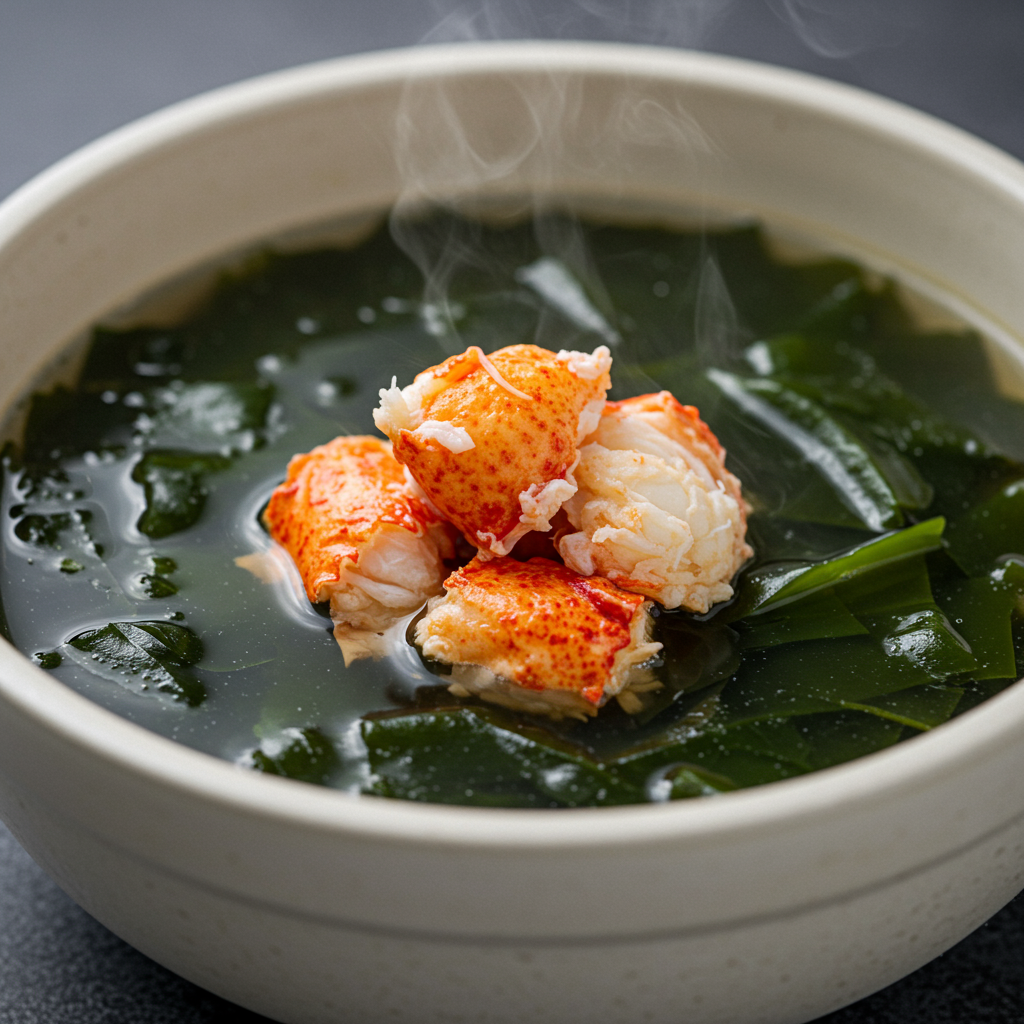
Miyeok-guk is a traditional Korean birthday soup, known for its restorative properties. Adding lobster transforms it into a special occasion soup that’s both delicate and deeply savory.
Ingredients:
- 1 oz dried miyeok (Korean seaweed)
- Meat from 1-2 lobsters, cut into chunks
- 6 cups water or light broth
- 2 tablespoons sesame oil
- 2 cloves garlic, minced
- 2 tablespoons soy sauce
- Salt to taste
Instructions:
- Soak Seaweed: Soak the dried seaweed in cold water for 20-30 minutes until fully rehydrated. Drain and cut into 2-inch lengths.
- Sauté Seaweed: In a large pot, heat the sesame oil over medium heat. Add the soaked seaweed and minced garlic and sauté for 2-3 minutes.
- Make the Soup: Add the water or broth and soy sauce. Bring to a boil.
- Cook Lobster: Reduce heat to a simmer. Add the lobster chunks and cook for 3-4 minutes, just until they are opaque.
- Season and Serve: Season with salt to taste. Serve hot.
Pro-Tip: Don’t overcook the lobster in the soup. Add it at the very end of the cooking process to keep it tender and succulent.
11. Sweet and Spicy Lobster (Kkanpung Lobster)
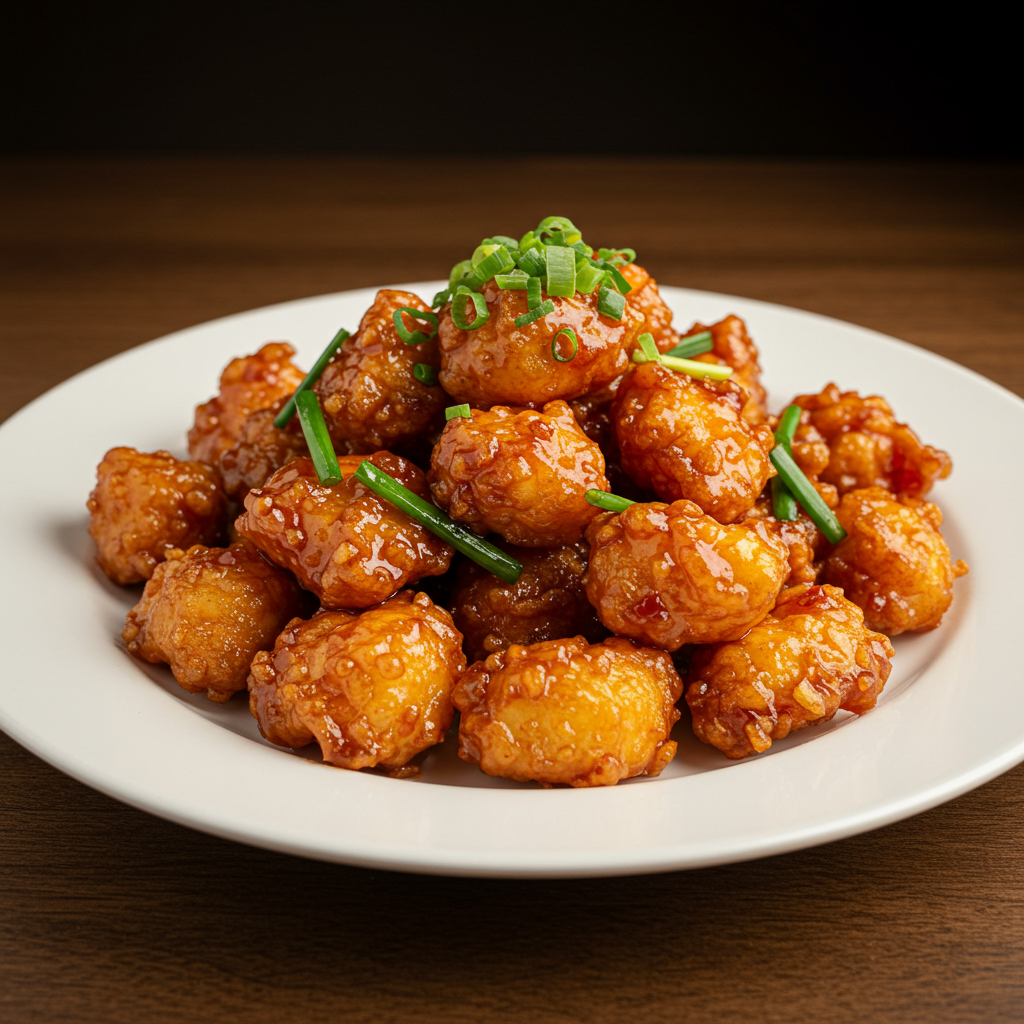
Inspired by the popular Korean-Chinese chicken dish, this recipe features crispy fried lobster tossed in a sticky, sweet, and spicy garlic sauce.
Ingredients:
- Meat from 4 lobster tails, cut into 1-inch pieces
- 1/2 cup potato starch or cornstarch
- Oil for frying
- For the Sauce:
- 3 tablespoons soy sauce
- 3 tablespoons sugar
- 3 tablespoons rice vinegar
- 3 cloves garlic, minced
- 1 small dried red chili, chopped (or more to taste)
- 1 green onion, chopped
Instructions:
- Coat Lobster: Pat the lobster pieces dry. Toss them in the potato starch until evenly coated.
- Fry Lobster: Heat 2 inches of oil in a pot to 350°F (175°C). Carefully fry the lobster pieces in batches for 2-3 minutes until golden and crispy. Drain on a wire rack.
- Make the Sauce: In a wok or large skillet, heat a tablespoon of oil. Sauté the garlic and dried chili for 30 seconds until fragrant.
- Combine: Add the soy sauce, sugar, and vinegar. Bring to a boil and let it bubble for a minute to thicken slightly.
- Toss and Serve: Turn off the heat. Add the fried lobster and chopped green onion to the pan and toss quickly to coat everything in the glossy sauce. Serve immediately.
Pro-Tip: The key to a crispy coating is the double-fry method. Fry the lobster once, let it cool for a few minutes, then fry it again for 1 minute before tossing in the sauce.
12. Korean Curry Lobster
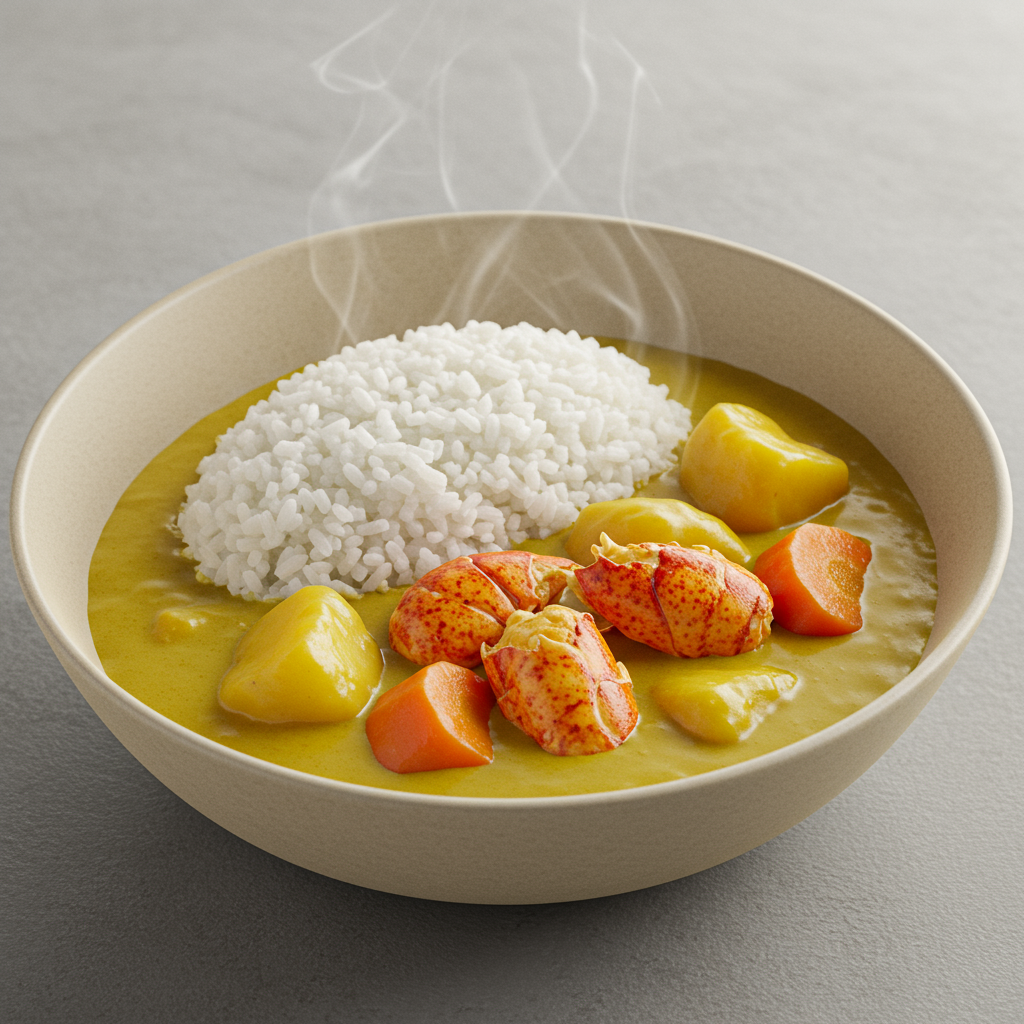
Korean-style curry is milder and slightly sweeter than its Indian or Thai counterparts. It has a golden color and a comforting flavor that pairs wonderfully with seafood.
Ingredients:
- Meat from 2-3 lobster tails, in chunks
- 1/2 packet of Ottogi or S&B Korean curry mix
- 2 cups water
- 1 potato, diced
- 1 carrot, diced
- 1/2 onion, chopped
- 1 tablespoon vegetable oil
Instructions:
- Sauté Vegetables: In a pot, heat the oil and sauté the onion, potato, and carrot for 5 minutes until the onion is translucent.
- Make Curry: Add the water and bring to a boil. Cook until the vegetables are tender, about 10-15 minutes.
- Dissolve Curry Mix: Reduce the heat to low. Break up the curry roux block and add it to the pot, stirring constantly until it has completely dissolved and the sauce has thickened.
- Add Lobster: Stir in the lobster chunks and cook for just 2-3 minutes until they are opaque.
- Serve: Serve hot over a bed of steamed white rice.
Pro-Tip: Prepare all your vegetables and have them ready to go. This dish comes together quickly once you start cooking.
13. Lobster Bibimbap
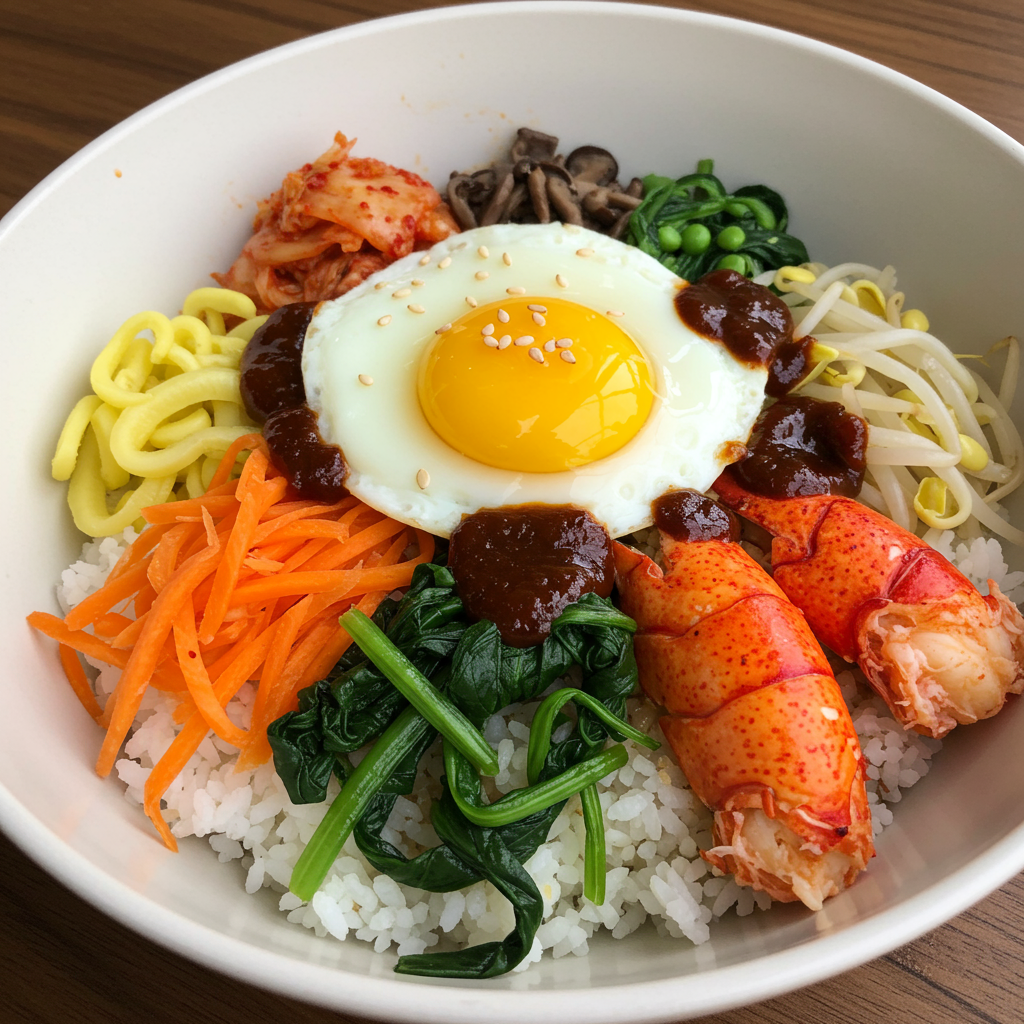
Bibimbap means “mixed rice,” and it’s one of Korea’s most famous dishes. This version tops the colorful bowl of rice and vegetables with buttery, pan-seared lobster instead of the traditional beef.
Ingredients:
- 2 cups cooked short-grain rice
- Meat from 2 lobster tails, pan-seared in butter and cut into pieces
- Assorted vegetables (julienned carrots, blanched spinach, sautéed zucchini, bean sprouts)
- 1 fried egg, sunny-side up
- Gochujang sauce for serving
- Sesame oil
Instructions:
- Assemble the Bowl: Place a serving of warm rice in a large bowl. Drizzle with a little sesame oil.
- Arrange Toppings: Arrange the prepared vegetables and the lobster meat in neat sections on top of the rice.
- Top with Egg: Place the fried egg in the center of the bowl.
- Serve: Serve with a bottle of gochujang sauce on the side. To eat, add your desired amount of sauce, and use a spoon to mix everything together thoroughly before taking a bite.
Pro-Tip: The beauty of bibimbap is its versatility. Use any vegetables you have on hand. Sautéed mushrooms, pickled radish, and fresh lettuce all work great.
14. Perilla Leaf and Lobster Pancakes (Kkaennip Jeon)
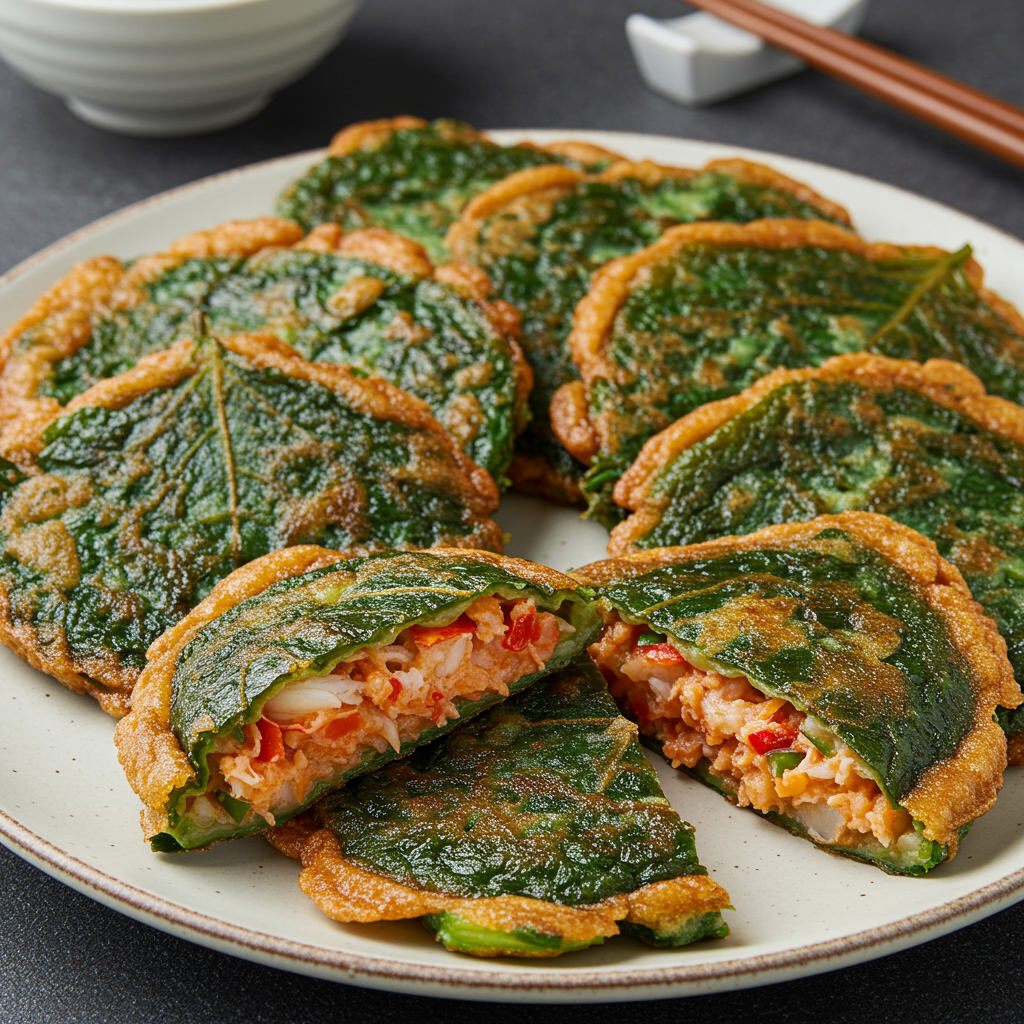
A savory Korean pancake (jeon) where perilla leaves are stuffed with a minced lobster filling, coated in a light batter, and pan-fried. The unique, minty-anise flavor of perilla is a fantastic match for lobster.
Ingredients:
- 12 large, fresh perilla leaves
- Meat from 1 lobster tail, very finely minced
- 1/4 cup minced tofu, squeezed dry
- 1 green onion, finely chopped
- 1 clove garlic, minced
- 1/2 cup all-purpose flour
- 1 egg, beaten
- Oil for pan-frying
Instructions:
- Make Filling: In a bowl, mix the minced lobster, tofu, green onion, and garlic. Season with a pinch of salt and pepper.
- Stuff Leaves: Dust the inside of each perilla leaf with a little flour. Place a small spoonful of the filling on one half of the leaf and fold the other half over.
- Coat and Fry: Lightly coat the stuffed leaves in flour, then dip them in the beaten egg.
- Pan-Fry: Heat oil in a skillet over medium heat. Fry the pancakes for 2-3 minutes per side, until golden brown and the filling is cooked.
- Serve: Serve with a simple dipping sauce made of soy sauce and vinegar.
Pro-Tip: Perilla leaves can be found at Korean or other Asian grocery stores. If you can’t find them, large shiso leaves are a good substitute.
15. Simple Steamed Lobster with Gochujang Vinaigrette
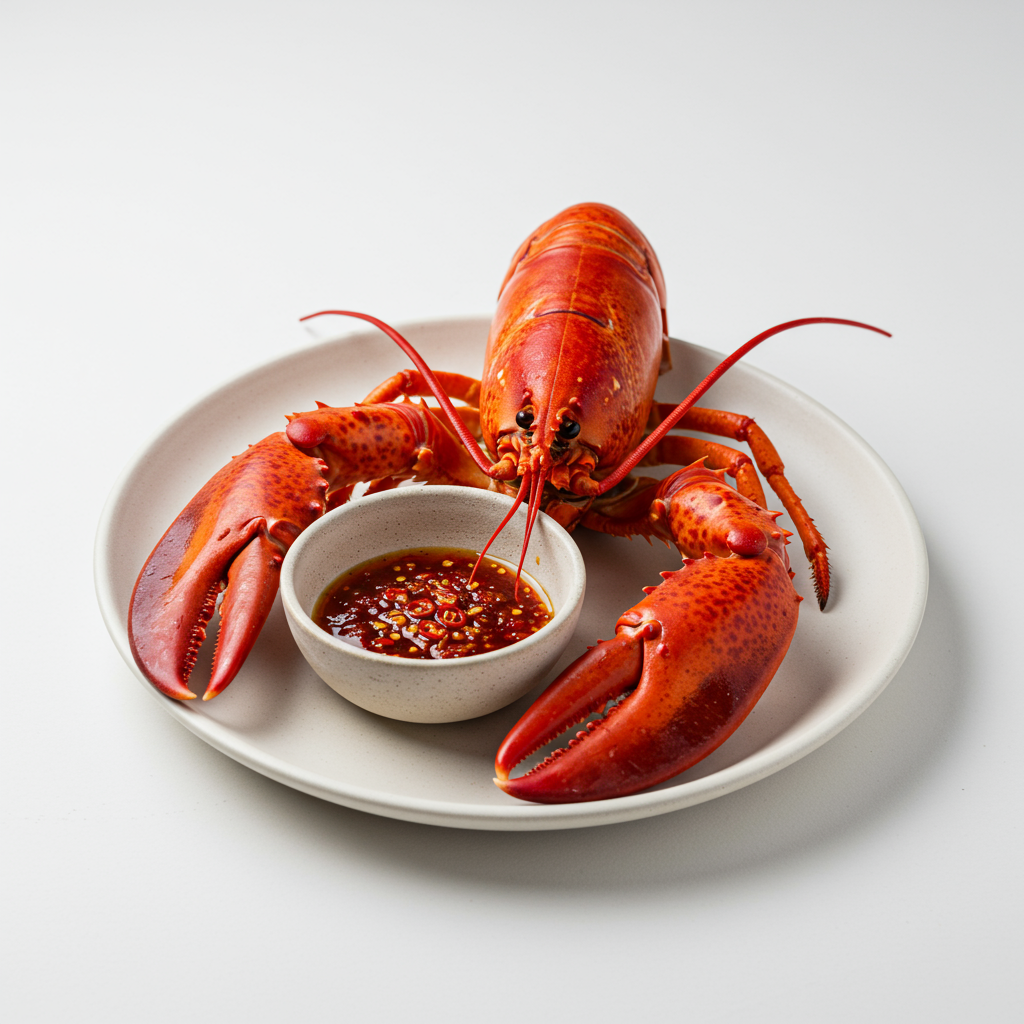
Sometimes, the simplest method is best. Steaming keeps the lobster meat incredibly tender and juicy. A zesty, spicy gochujang vinaigrette served alongside provides the perfect Korean flavor punch.
Ingredients:
- 2 whole lobsters
- For the Vinaigrette:
- 3 tablespoons gochujang
- 3 tablespoons rice vinegar
- 2 tablespoons sesame oil
- 1 tablespoon honey or sugar
- 1 clove garlic, grated
Instructions:
- Steam Lobster: Set up a large pot with a steamer basket and an inch of water. Bring to a boil. Place the whole lobsters in the basket, cover, and steam for 12-15 minutes (for 1.5 lb lobsters), until bright red and cooked through.
- Make Vinaigrette: While the lobster steams, whisk all the vinaigrette ingredients together in a small bowl until smooth.
- Serve: Remove the lobster from the pot. You can crack it for your guests or serve it whole with crackers and picks. Serve the gochujang vinaigrette on the side for dipping the sweet meat into.
Pro-Tip: Don’t overcrowd the steamer pot. Cook the lobsters in batches if necessary to ensure they cook evenly.
Frequently Asked Questions
1. What is gochujang and where can I find it? Gochujang is a fermented Korean chili paste that’s a staple in Korean cooking. It’s savory, sweet, and spicy. You can find it in tubs at most Asian grocery stores and in the international aisle of many large supermarkets.
2. Can I use a whole lobster instead of just tails? Yes! Many of these recipes work wonderfully with whole lobsters. You can split them in half for roasting and grilling, or boil/steam them and use the meat from the claws and body as well as the tail.
3. What’s the best way to humanely kill a lobster? The most widely accepted humane method is to place the lobster in the freezer for about 30 minutes to numb it. Then, place it on a cutting board and swiftly drive a large, sharp chef’s knife down through the head, starting just behind the eyes.
4. What Korean side dishes (banchan) go well with lobster? Classic banchan like kimchi, pickled radish (danmuji), seasoned spinach (sigeumchi namul), and spicy cucumber salad (oi muchim) would all be fantastic. Their tangy and fresh flavors help balance the richness of the lobster.
5. Can I make these recipes less spicy? Of course. The heat in these recipes primarily comes from gochujang and gochugaru. You can easily reduce the amount called for in any recipe. Look for “mild” versions of gochujang, which have less heat but still provide that essential savory flavor.
Conclusion
Exploring Korean cuisine through the lens of a luxury ingredient like lobster opens up a whole new universe of flavor. As you’ve seen, Korean cooking techniques and ingredients can transform lobster in countless ways—from the fiery passion of a gochujang glaze to the comforting embrace of a cheesy topping. The key takeaway is the principle of balance. Each dish strives for a harmony between spicy, sweet, savory, and tangy, ensuring every bite is an exciting adventure.
Beyond the recipes themselves, consider the communal nature of Korean dining. Many of these dishes, like the spicy stew or the BBQ skewers, are perfect for sharing. They are meant to be enjoyed with friends and family, gathered around a table, passing side dishes and sharing stories. So, the next time you decide to cook lobster, don’t just make a meal—create an experience.






